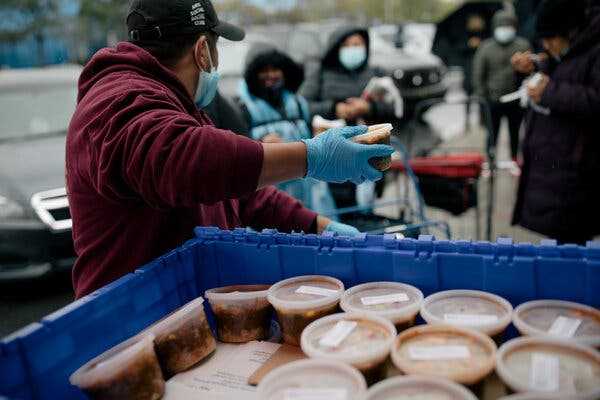Two years after the federal government approved $350 billion in emergency funding for states and localities to respond to the public health crisis, much of the funds have not been used.
- Share full article

A food pantry in New York City in 2020. States spent much of their funds on addressing the negative economic impacts of Covid-19.
A year after the Covid-19 pandemic’s onset, the federal government approved $350 billion for state, local and tribal governments to maintain vital services and provide aid to families and businesses. Even after the public health emergency has officially ended, much of the funds have yet to be spent.
State and local governments had spent less than half of the funds as of March 31, the most recent data available, according to a Government Accountability Office report released on Wednesday.
States had spent 45 percent, or $88.2 billion, and made commitments for 60 percent, or $118.3 billion, of the money, according to the report. Local governments had spent 38 percent and committed 54 percent.
Some local governments have also failed to report their spending to the Treasury Department, which oversees the funding. About 14 percent of localities, which collectively received $3 billion, did not submit mandatory reports on how they have used the funds as of the end of March, the Government Accountability Office found. In August, Treasury officials sent notices of noncompliance to most of those localities.
The $350 billion was included in the Biden administration’s American Rescue Plan, a $1.9 trillion stimulus package that also provided direct aid to households and small businesses struggling to recover during the pandemic. The money was meant to prevent painful budget cuts, which state and local governments had to make when revenues plunged and costs spiked during the Great Recession last decade. That prolonged the nation’s recovery and constrained some local economies for years.
States and local governments were given wide latitude to use the funds. Some recipients have funded infrastructure upgrades, Covid-19 testing efforts and programs to provide shelter for homeless people. Others have approved plans to spend millions on stadium renovations and sports complexes.
State and local governments have not exhausted their funding in part because they have until the end of 2026 to spend the money. Disagreements over how the funds should be spent have slowed planning in some communities.
The largest share of funds has been spent on replacing revenue that was lost as a result of the pandemic, according to the accountability agency report. During the early days of the pandemic, many state and local governments had projected revenue losses of as much as 20 percent.
Federal officials allowed recipients to use the funds to cover a broad range of government services, up to the amount of revenue lost because of the pandemic. California, for example, spent $16.7 billion on restoring state employee pay cuts and funding public programs, among other things. Louisiana spent $115 million to construct roads and bridges.
Thirteen states used at least 50 percent of their awards to replace revenue, while seven states did not spend any funds to do so, according to the accountability agency.
States also spent much of their funds on addressing other negative economic impacts of Covid-19. Many contributed to state unemployment insurance trust funds. Michigan spent $25.6 million on a marketing campaign for tourism in the state.
- Share full article
SKIP ADVERTISEMENT
Source: nytimes.com



